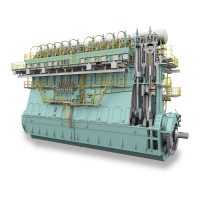Operation
4002−1/A1
Winterthur Gas & Diesel Ltd.
7/ 22
2.1 Power Supplies
Two 230 VAC supplies from the ship installation supply electrical power to E85.1 to
E85.n. The two 230 VAC supplies are isolated (see Fig. 2).
WARNING
Injury Hazard: The power supplies have redundancy. If it is
necessary to isolate the ECS, make sure that each of the two
230 VAC power supplies are set to off. This will prevent injury to
personnel.
Note: Each module and the LDU-20 at the local maneuvering stand have two
power 24V supplies. This makes sure of redundancy. An AC/DC converter
from the ship installation supplies the LDU-20 in the engine control
room (ECR). If one power supply becomes defective, the failure causes
an alarm in the Alarm and Monitoring System (AMS).
2.2 Installation on the Engine
The engine control system is an embedded system and has no central computer. The
ECS modules are installed on the engine near the sensors and different actuators.
The CCM-20 are installed in the terminal box E95.
The IOM-10 is installed in the terminal box E90 (shipyard interface box). The terminal
box E90 is attached to the rail unit at the free end of the engine.
The MCM-11 and LDU-20 are installed in the local control box E25. The local control
box E25 is installed at the free end of the engine.
For more data, see 9362−1 Location of ECS Electronic Components.
2.3 Redundancy
Each control function that is important for engine operation has redundancy in the
engine control system (ECS).
If a CCM-20 becomes defective, the related cylinder will be shut off and a decrease in
engine load will follow (slowdown). Each CCM-20 receives reference data for the
injection period (fuel quantity) from the speed controller through the double CAN
communication busses (see paragraph 3.5).
If a sensor is defective (e.g. fuel rail pressure sensor), the failure causes an alarm in
the AMS. The failure is shown on the LDU-20.
Redundant sensors are used for all important parameters (e.g. if one speed sensor is
defective, engine operation will continue).
If the speed controller or the complete MCM-11 become defective, you can operate
the engine from the LDU-20 at the local maneuvering stand or from the LDU-20 in
the ECR (only in fuel command mode).
2015-12
Engine Control System

